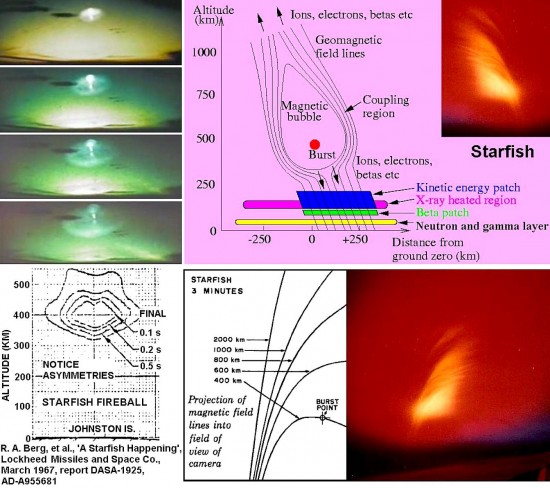
The detonation of a 1.4 megaton thermonuclear device at an altitude of 400 kilometers created a plasma cloud with evident striations. Also note ionic coupling with the ground. Credit: Lockheed Missiles and Space/R.A. Berg, et al.
Mar 31, 2016
Are you noisy with quiet times?
— Shel Silverstein, A Light in the Attic
Earth is an electrically active body because it has a plasmasphere. As described elsewhere, it is plugged into circuits that are part of a relationship that it has with the Sun and with other planets and moons in the Solar System. That relationship, along with other factors, such as cosmic rays, means that Earth holds an electric field at its surface of between 50 and 200 volts per meter, known as the “fair weather field”. This means that a person two meters tall will experience a potential of up to 400 volts from head to toe. However, the average potential between ground and the ionosphere, called “the atmospheric electric potential”, is 240,000 volts, but can reach as much as 400,000 volts.
Electric charge separation occurs in the upper atmosphere because “tidal winds” move the ionospheric plasma against Earth’s magnetic field, inducing powerful electric fields and currents. The tidal wind charge effect is connected to the Sun by incoming Birkeland currents described elsewhere. Earth’s electric field is complex, with many different divisions. Between 100 and 200 kilometers is the “dynamo region” where there is the greatest conductivity in Earth’s magnetic field, or its “maximum electric equipotential”. It is there that a 140,000 ampere current is generated through transformer action: the dynamo region acts as the primary coil, while Earth is the secondary.
An electrically active magnetotail (or plasma tail) extends for millions of kilometers from Earth. Charged particles from the Sun, otherwise known as the solar wind, together with ions generated by the Earth, gather in a plasma sheet inside the magnetotail. Earth’s magnetic field causes these particles to spiral around the poles as well as to bounce between them. Some ions circle the Earth in two bands at low latitudes. Electrons move in one direction and protons in the opposite direction. Transformer action, along with electromagnetic induction, contributes to those east-west bands. The largest electric charge flow along Earth’s geomagnetic equator takes place in the dynamo region.
All of this activity generates a considerable amount of radio noise that propagates through the atmosphere from pole to pole. Anyone who has tuned a radio between stations and heard whistling, warbling, roaring, clicking or other sounds has heard the seemingly chaotic fields of Earth and its electrical buzz. Since plasma is composed of charged particles, any movement constitutes an electric current, which generates a magnetic field. Electrons spiral in the resulting magnetic field, creating synchrotron radiation that can shine in all frequencies, including radio waves.
Recently, scientists from MIT, UCLA, and the University of Sheffield, among others, detected a “remarkably orderly pattern amid the noise” created by Earth’s complicated electrical linkage. As the press release states, each plasma wave, or striation, was a “proton gyrofrequency” harmonic. Proton gyrofrequency relates to the solar wind plasma, and is based on the movement of the positively charged band of ions mentioned above. Proton gyrofrequency waves have also been called “ion cyclotron waves” by other research groups studying the Sun. The announcement from MIT concludes that the regular pattern of striations are most likely generated by protons in the Van Allen radiation belts.
Hannes Alfvén, in the introduction to his book, Cosmic Plasma, points out examples of plasma behavior that he observed in his lab:
“The plasma exhibited striations, double layers, and an assortment of oscillations and instabilities. The electron temperature was often found to be one or two orders of magnitude larger than the gas temperature, with the ion temperature intermediate.”
The recently announced plasma striations are further confirmation of Electric Universe theories. However, as observations progress, the complexity of plasma’s behavior appears to progress right along with them. More information generates more questions. Since plasma is an emergent phenomenon, it can not be analyzed in terms of its component parts, it arises in response to several factors. Such properties as filamentation, long-range attraction and short-range repulsion, braiding, characteristic velocities, formation and decay of plasmoids, and identity of properties at different scales are all aspects of the plasma phenomenon. More data will add to that mix.
Stephen Smith












